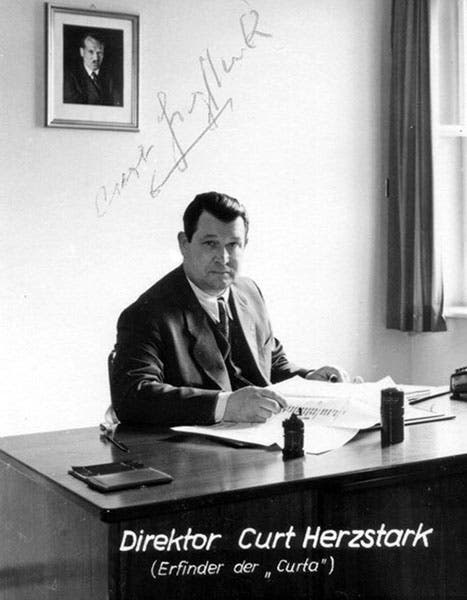Scientist of the Day - Curt Herzstark
Curt Herzstark, an Austrian machinist and engineer, was born July 26, 1902, in Vienna. Herzark's father was also an engineer and ran a factory in Vienna that made mechanical calculators. The son began with the firm as a precison machinist, then moved into sales, and rose to a managerial position by 1930. He showed his mechanical genius by inventing the Multimator, a calculator that could provide running totals, which no one had managed before, not even the Americans. From his customers, Herzstark learned that there was a need for a small but accurate four-function mechanical calculator, meaning a device that could add, subtract, multiply, and divide, something that could rival the portability of a slide rule but provide the higher accuracy of a mechanical calculator. Mechanical calculators of those days were very bulky and expensive and could hardly be carried from job to job.
By 1938, Herzmark had come up with a design for a pocket mechanical calculator, something you could hold in the palm of one hand and operate with the other. Unfortunately, 1938 was also the year that Nazi Germany annexed Austria, and the factory was immediately diverted to making gauges for the German Army. Although Herzstark senior was Jewish, and Curt was thus half-Jewish, he was allowed to keep his job, although his firm no longer made calculators. Then, in 1943, Curt was arrested on spurious charges and sent to the concentration camp at Buchenwald. After a few months he was recognized as a skilled engineer and was moved to the factory associated with Buchenwald, where thousands of skilled prisoners worked to make precision equipment for the German war effort. Authorities learned about his plans for a miniature calculator, and Herzstark was instructed to reproduce it so that a prototype could be built to give to Hitler as a present. Herzstark managed to reconstruct from memory detailed plans for the entire device, which, when you see how complicated it was, is quite astounding. Fortunately for Herzstark's mental well-being, Buchenwald was liberated by the allies before his plans could be used to build anything.
After the war, Herzstark faced a new menace, the Soviets, and he fled back to Vienna, where he decided to put his calculator into production. The prospect intrigued the little duchy of Liechtenstein, which was trying hard to enter the 20th century, and so a factory was set up there, and the first calculator emerged in 1947. It was called, after its maker, the CURTA. Between 1947 and 1972, 80,000 of the original calculators (called Type 1) were produced, and another 60,000 of a larger-capacity version (Type 2). The last type 1 was almost identical to the first one. Not many devices emerged from its inventor’s mind as fully formed and as accurately conceived as this one.
The CURTA is as amazing a mechanical device as you are ever likely to encounter (first image). Shaped like a cylinder about 2" in diameter and 3.4" tall, with a small rotating crank on top, it looks very much like a precision nutmeg grinder. Numbers are entered by moving 8 sliders up or down on the side, with the numbers selected showing in tiny slots just above, and operations proceed when you give the small crank a complete turn. Results show in windows on the top. The CURTA will add, subtract, multiply, and divide. With a few algorithms, you can take square roots. To me, the most astonishing thing about the CURTA is that you change from addition to subtraction by pulling the crank to an "up" position, which raises it all of 3 mm. But now, when you turn the crank, an entirely new set of gears and cams are engaged to produce a difference instead of a sum. This is made possible by the heart of Herzstark’s invention, a complicated stack of cams called a step drum that it is impossible to describe and must have been nearly as impossible to design and build. There are 600+ parts in a CURTA, 137 of them unique. Here is a poster that shows many of the CURTA’s innards. I have always wanted to take one apart, but never dared.
The best way to appreciate a CURTA is to hold one, but since that is not possible for most of you, you can watch a video of a CURTA in operation on YouTube. There are many of them; here is a short one, and you will be offered others if you watch this one. CURTA owners are a proud lot and number in the tens of thousands; CURTAS have not been manufactured for almost 50 years, but they still work as well as ever, and still sell actively on eBay, although it will cost you a grand to bid on one.
Herzstark as a human being was almost as remarkable as his calculator. He emerged from the most brutal war experience, one that psychologically and physically devastated tens of thousands of people, with his humanity intact. He lived until 1988 and was interviewed several times in his 80s, and he could talk about the Nazi era and his Buchenwald experience matter-of-factly, without bitterness or anger, even though he had seen humankind at its absolute worst. His last set of interviews was turned into a book after he died; it is still available from the Oughtred Society. I read it while writing this post and highly recommend it.
In an interesting footnote, an article on the CURTA and its history was published in Scientific American in 2004. The author was Clifford Stoll, who made the Klein bottle we featured in our post on Felix Klein last month.
Dr. William B. Ashworth, Jr., Consultant for the History of Science, Linda Hall Library and Associate Professor emeritus, Department of History, University of Missouri-Kansas City. Comments or corrections are welcome; please direct to ashworthw@umkc.edu.







